Key Developments in the History of
Buttress Dams
|
Roman Buttress Dams
Esparragelejo
Whenever Roman engineers, often erroneously, judged the stability of a dam wall to be
inefficient, they backed it up by irregularly spaced buttresses. A third of the
Roman dams in the Iberian peninsula were buttress dams. The designs were not yet
perfected. Some dams were too thin. Buttress could not prevent the failure of
the super thin, 0.9 m dam wall at Ituranduz. By contrast, some dams were over designed.
The Olisipo dam was 6.5 m thick and didn't need help from its buttresses. The most
remarkable of the Roman buttress dams is the one near the village of Esparragalejo.
The 5.6 m high and 320 m long dam was supported in its central part with 12 buttresses
averaging 1.2 m wide, 3.2 m thick and spaced 8.6 m apart. However, the novel feature
was that the downstream face of the 2 m wide dam wall became curved between the
buttresses. Thus, the first multiple arch dam was born!
|
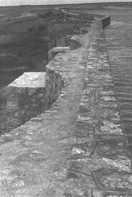
The Esparragelejo Dam
photo from Schnitter
courtesy of
A.A. Balkema (#)
|
Buttress Dams in Postmedieval Europe
Castellar
The Castellar storage dam in Spain was built around 1500 and had three water
wheels to power its mill house. The sturdy end and walls of the mill house
were actually buttresses ensuring the dam's stability. It is certainly no
coincidence that this structural concept re-emerged in a region in which the
Romans had built many buttress dams. |
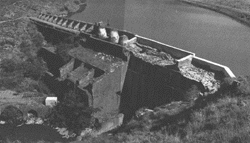
The Casterllar Dam
photo from Schnitter
courtesy of
A.A. Balkema (#)
|
|
Further Iberian Construction
The dams in Spain and Portugal continued the progress of mill dams that was
initiated by the medieval Castellar dam. Like the latter, the Casabaya dam
had to rely on the end and intermediate walls of the mill house at its toe
for stability. But already from 1565 to 1570 the young architect Francisco
Becerra (1545-1605) built the Casillas II dam 28 km SW of his native towm
Trujillo in the old Roman manner, i.e. a rectangular water retaining wall
propped up by rather closely spaced buttresses. In 1572 he started the
construction of the larger San Jorge dam 2km SW of Trujillo, but he left
for the Spanish colonies in America, where he became a famous architect.
The dam was only completed in 1690 and it had such a sturdy water retaining
wall, that the widely spaced buttresses were unnecessary. This also held
true for the Feria built in 1747/1950 and originally some 19 m high. The
spaces between five of seven of its buttresses not only contained two
mills but, since the dam's construction was ordered by a bishop, they
were also enhanced by a chapel!
|
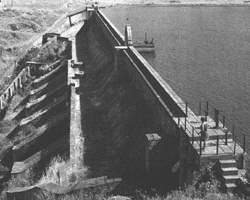
The Feria Dam
photo from Schnitter
courtesy of
A.A. Balkema (#)
|
|
Peruzzi
A few years prior to the construction of the Feria dam, five smaller structures
were built near Bilbao, Spain. For the first time since the Esparragalejo dam a
multiple-arch buttress dam was built. Actually, this concept had already been
proposed 200 years earlier in 1530 by the architect Baldassare Peruzzi in Siena,
Italy for the reconstruction of the failed fish pond on the river Bruna. He
envisioned a series of arches supporting a slab, which sloped upstream. Around
30 years later, the idea reappeared in "The Twentyone Books of Devices and Machines"
an unpublished Spanish codex. Their author correctly noted that the water load on
the sloping upstream face would increase the dam's stability. |
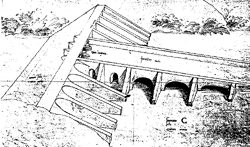
soon: Peruzzi's Plan
sketch from Schnitter
courtesy of
A.A. Balkema (#)
|
|
This recommendation was followed by the bulider of the Bilbao dams, the Basque
nobleman Pedro B. Villareal de Berris (1670-1740). He was interested in water power
and published a relevant book in 1736. However, the downstream faces of his arches
were vertical like at Esparragalejo, so that their width increased considerably
between the dam's crest and base and even more so towards the buttresses. All five
dams were less than 5 m high and consisted of one to five arches with spans between
15 m and 12 m. With the exception of one which suffered from the chemical action
of watse-waters, they are all in excellent state of preservation.
|
Buttress Dams Elsewhere
India
The extraordinary Mir Alam multi-arch dam was completed in 1804 for the water supply
of Hyderabad. This dam was unquestionably the work of Henry Russel, a member of the
British Royal Engineers. The structure, reaching a height of 12 m, consisted of 21
semicircular, vertical arches that were of constant thicknesses and variable spans.
100 years went by before a dam of similar design was built. Therefore, the Mir Alam
dam must be considered as one of the rare, true strokes of genius!
Evolution of the Modern Buttress Dam
Today we understand buttress dams as derivations from the massive gravity type
with the introduction of intermediate spaces. These spaces allows the discharge of
water seeping through the dam and its foundation, thus greatly reducing uplift
pressures. Given the absence of uplift, more substantial savings were possible by
inclining the upstream face, thereby mobilizing the vertical water load on the
upstream face for sliding stability.
|
|
Multiple Arch
The first multiple arch dam of reinforced concrete had been completed in 1908.
It impounded the Hume Lake fluming reservoir on the Ten Mile creek in the
California Sierra Nevada Mountains. The dam was designed and supervised
during constuction by John S. Eastwood (1857-1924). He also designed the Big
Bear Valley dam in the San Bernardino mountains. Eastwood's designs were
very economic: the required less concrete than an equivilant gravity dam and
cost less, too. Overall, a dozen multi-arch dams were built in the following
decade and a half according to Eastwood's design.
Check out a book on Eastwood. |
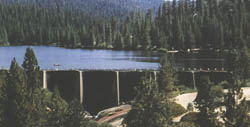
The Hume Dam
photo courtesy of Bill Huf
USDA Forest Service (#)
|
|
A decidely larger arch span of 54.9 m was acheived in 1928 at the 76 m high
Coolidge dam in Arizona. This was the first application of the double-curved dome structure
to buttress dams. Coolidge Dam provides water for irrigation, power, and recreation. |
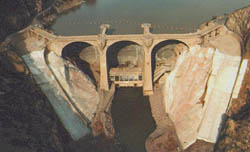
The Coolidge Dam
photo from US Bureau of Reclamation
|
|
After World War II, large-span multiple-arch dams were pursued further by the
prominent French dam designer Andre Coyne (1891-1960). In prewar Europe, multiple
arch structures had attained a certain importance only in Italy during the 1920's.
After the war, several of them were built in France, among such sizable structures
as the 88m high Grandval Dam built in 1959 with a 50 m span. However, Coyne's most
important project of this type was built in the years from 1961 to 1968 in northern
Canada. On the Manicougan river in Quebec was built the Daniel Johnson dam. It was
an unprecedented 214 m high with a central span of 162 m and smaller side spans of
76 m each!! Unfortunately, the elegant structure was plagued by numerous
cracks. |
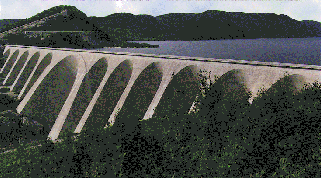
The Daniel-Johnson Dam
photo from Hydro-Quebec (#)
|
|
Flat Slab Buttress
The hottest competitor to multiple arch was the type of flat slab buttress designed
and patened by Nils F. Abursen in 1903. Abursen's design took full advantage of the
stabillizing effect of the vertical water load on the strongly inclined upstream
face, which required a minimal buttress thickness per unit of dam length. The
Abursen dam type soon became quite popular and, by the end of the 1920's, more than
200 had been constructed, thus outnumbering multiple arch dams by far. Outside the
US, the flat slab buttress design was especially adopted ofter WWII for about 50
dams exceeding 15 m in height in Ambursen's native Norway. Almost no flatslab
buttresses were built in the rest of Europe and only a few in Latin America.
However, the highest of them all was 83 m high and completed in 1948 at Escaba,
Argentina. |
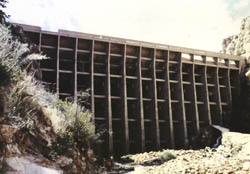
The Le Prele Dam
photo from Kollgaard and Chadwick
|
|
Contiguous Butresses
There was an introduction of a new kind of design in which the arches or slabs as
upstream closures of the intermediate spaces between the buttresses were replaced by
a thickening of their heads to make them contiguous. Such a design was used 1927-1928
by Noetzli for the 35 m high spillway section of the V. Carranza irrigation dam in
Mexico. The same is true for the 26 m high Burgomillodo dam, completed in 1929 in
Spain by Spainish engineer Federico Cantero. The Dixence dam in Switzerland had II
shaped buttresses. It was the world record in height for a buttress (87m) dam until
after WWII. This dam has now been submerged by the reservoir from the Grand Dixence
gravity dam in 1957. |
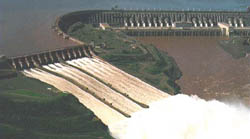
The Itaipu Dam
photo from Itaipu Binacioinal
|
|
The Dixence design was adopted during WWII by Claudio Marcello (1901-1969). He
modified it a little and made it standardized. In fact, for most of the buttress
dams built in the last decades, either Marcello's double buttress or Noetzli's single
buttress were adopted. The largest hydropower plant built so far, namely the Itaipu
on the border of the Brazilian Paraguy border, has a double buttress main dam with
an unprecedented height of 196 m and a long wingwall of single buttresses.
|
 
|


